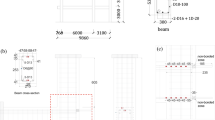Abstract
High-Performance Concrete (HPC) as a promising construction material has been widely used in infrastructures and high-rise buildings etc. However, its high autogenous shrinkage especially in its early age becomes one of the key problems endangering longterm durability of HPC structures. This paper reports the study of early age autogenous shrinkage of large scaled HPC column specimens by embedded Fiber Bragg-Grating (FBG) strain sensor. Temperature compensation for FBG strain sensor by thermocouple was also attempted in this paper, and the results were reasonable and acceptable comparing with the result compensated by FBG temperature sensor. Reinforcement influence, size effect and temperature effect on HPC autogenous shrinkage were also analyzed respectively in this paper.
Similar content being viewed by others
References
Aïctin, P. C. (1999). “Autogenous shrinkage measurement.” Autogenous Shrinkage of Concrete, Edited by Tazawa, E., E & FN Spon, pp. 257–268.
Aitcin, P. C., Neville, A. M., and Acker, P. (1997). “Integrated view of shrinkage deformation.” Concrete International, Vol. 19, No. 9, pp. 35–41.
Davis, H. E. (1940). “Autogenous volume change of concrete.” Proceeding of the 43rd Annual American Society for Testing Materials, ASTM, pp. 1103–1113.
Holt, E. (2005). “Contribution of mixture design to chemical and autogenous shrinkage of concrete at early ages.” Cement and Concrete Research, Vol. 35, No. 3, pp. 464–472.
Japan Concrete Institute (1996). Test method for autogenous shrinkage and autogenous expansion of cement paste, mortar and concrete, Report by Technical Committee on Autogenous Shrinkage of Concrete, pp. 195–198.
Loukili, A., Chopin, D., Khelidj, A., and Touzo, J. L. (2000). “A new approach to determine autogenous shrinkage of mortar at an early age considering temperature history”. Cement and Concrete Research, Vol. 30, No. 6, pp. 915–922.
Nawa, T. and Horita, T. (2004). “Autogenous shrinkage of high-performance concrete.” Proc. of the international Workshop on Microstructure and Durability to Predict Service Life of Concrete Structures, Japan.
Neville, A. M. (1995). Properties of concrete, 4th edition, Longman, London.
Saje, D. and Saje, F. (2001). “Autogenous shrinkage development in HPC.” Bridge materials, pp. 11–20.
Tazawa, E. and Miyazawa, S. (1993). “Autogenous shrinkage of concrete and its importance in concrete technology.” Proceedings of the 5th International RILEM Symposium, In: Creep and Shrinkage of Concrete, Bazant, Z. P. and Carol, L. (eds.), E & FN Spon, London, pp. 159–168.
Wong, A. C. L., Childs, P. A., Berndt, R., Macken, T. (2007). “Simultaneous measurement of shrinkage and temperature of reactive powder concrete at early-age using fiber Bragg grating sensors.” Cement Concrete Comp, Vol. 29, No. 6, pp. 490–497.
Yang, Y., Sato, R., and Kawai, K. (2005). “Autogenous shrinkage of high strength concrete containing silica fume under drying at early ages.” Cement and Concrete Research, Vol. 35, No. 3, pp. 449–456.
Zhang, M. H., Tam, C. T., and Leow, M. P. (2003). “Effect of water-to-Cementitous materials ratio and silica fume on the autogenous shrinkage of concrete.” Cement and Concrete Research, Vol. 33, No. 10, pp. 1687–1694.
Author information
Authors and Affiliations
Corresponding author
Rights and permissions
About this article
Cite this article
Yun, YW., Jang, IY. & Wang, WW. Early-age autogenous shrinkage of high-performance concrete columns by embedded Fiber Bragg-Grating sensor. KSCE J Civ Eng 16, 967–973 (2012). https://doi.org/10.1007/s12205-012-0811-6
Received:
Revised:
Accepted:
Published:
Issue Date:
DOI: https://doi.org/10.1007/s12205-012-0811-6




